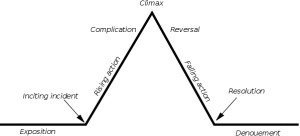Plot is nothing more than the way you organize your story.
 The way you fit the puzzle pieces together to form a connected and coherent picture for the reader.
The way you fit the puzzle pieces together to form a connected and coherent picture for the reader.
Plot is the glue that holds character and story together and that makes the story compelling to read.
You must look at your plot through the lens of three acts to consider the fundamentals of story.
When you create story characters, your challenge is to find a way to fit them into their own unique world. Just as plays and movies do, stories come in three basic acts.
Act I) Problem and Obstacle
In the first act, the hero encounters his central problem. He also encounters the first obstacle to solving the problem.
Act II) Conflict and Struggle
Here, the hero comes face-to-face with choices that create more conflict. Can he achieve his goal despite this, and despite this and despite this? The plot should have at least three major obstacles for the hero to overcome, each one more challenging than the one before.
Act III) Resolution
In the last act, the hero finds a way out of his dilemma and takes the final step towards resolving his problem.
These three acts form the basis of all your stories. When it comes to how you present your material, there’s a lot of fictional weekly room in which to move.
The Hero Quest
The hero quest rests at the heart of the story. This is the universal adventure, the journey – psychological or physical or emotional – that we take in both literature and life we set out in search of knowledge and wisdom.
The six stages of the hero quest
- The hero’s call to action.
- An irresistible force impulse the hero to accept the call.
- The hero crosses into the underworld.
- The hero confronts the greatest danger and achieves the ultimate truth.
- The hero is unsure he can leave the underworld.
- The hero decides to return to the upper world, but is change forever and cannot return to where he began.
This, then, is the hero’s quest: the journey from to understanding. The search for meaning and the longing for home. The passing through darkness on the way to the light.
As you write your story, conceive of your hero as going on her own quest.
Principles of a Strong Plot
Choose one idea, a few characters and a few incidents. Don’t overburden your story with too many plot lines, obstacles and distractions. If you have a strong character, you can create a textured and complex story within the structure of a simple plot.
Practice tough love. If a scene doesn’t advance the plot or develop the character, rewrite it or get rid of it.
Create defining conflict. At the beginning of the book, make certain the reader understands what the central conflict of the narrative is. This sets up the story for the action that follows.
Use plot to translate character interaction. When the hero confronts an obstacle, the action that follows is a result of the hero’s response to the obstacle. Reaction follows action; action follows reaction. The element of the plot drives the character’s behavior and evokes the responses that define the character.
Remember that choices create conflict. Without choice, there is no conflict. In literature, as in life, the torment of deciding between two equally weighted alternatives creates one of the most powerful conflicts a character can confront.
Use obstacles to pull the story from beginning to end. Moving from one obstacle to the next create steady forward momentum and helps maintain a strong storyline.
Write with a consciousness of pacing and tension. In the rising action of your story, you can maintain reader interest by upping the action ante with each succeeding scene. The initial obstacle the hero will become must be smaller than the one that follows.
Create suspense by creating limits. Limited time. The hero must accomplish his goal by a certain time, day or date, the motivation for continuing to read it automatically built into the story. Will the hero succeeding time or want he?
Limit revelations. Parcel out pieces of the plot puzzle one item at a time. Parcel out resolutions to the dilemma one detail at the time. Nothing should be solved all at once.
Remember That Action Springs from character. The way you keep your story compelling and your plot honest is to make certain that whatever your hero does, it comes out of an authentic place. The heroes character dictates the response to the action. Action does not dictate character.
Dramatize the resolution. As I emphasized in the section on endings, be sure to play out your ending in full and onstage. Anything less cheats the reader.
Subplot
A subplot is a story told in a quieter voice than the plot. Subplot add texture, interest and meaning to the plot. A storytelling devices, they supplement, enlighten and enlarge; the amuse, engage and complicate. The subplot is a way to tell another tale, a way to add interest, increase suspense and enrich your story. The subplot can be a reflection of the plot or stand in opposition to it.
Some stories have one subplot; some have several. The choice is up to you.
As a general rule, try to envision your story as a tale that includes both plot and subplots this allows you to expand the narrative horizons, and rich the texture, and increase the depth of both your action and your characters.
Notes about subplot characters
The weight rule. Be sure to give your protagonist the most weight in the story. Never forget that the hero is the most important character, the one to whom the most attention must be paid. The secondary character should never share equal time or prominence with the protagonist. This confuses the reader and leads her astray.
The scene rule. No matter how interesting the subplot is, the secondary character should never get as many scenes as the protagonist. If you violate this rule, you risk losing the readers allegiance to the hero. There is no precise formula for the scene count, but there should never be any question in the reader’s mind which character dominates the story.

